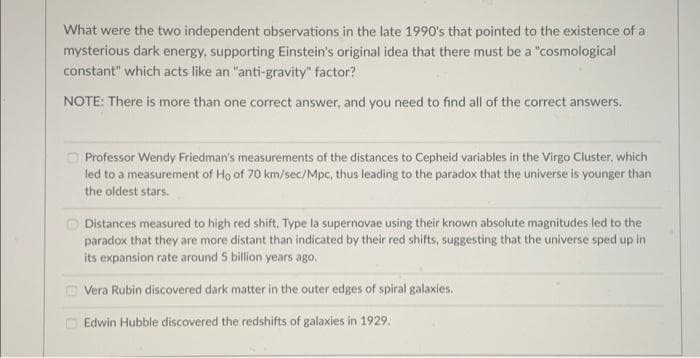What were the two independent observations in the late 1990's that pointed to the existence of a mysterious dark energy, supporting Einstein's original idea that there must be a "cosmological constant" which acts like an "anti-gravity" factor? NOTE: There is more than one correct answer, and you need to find all of the correct answers. O Professor Wendy Friedman's measurements of the distances to Cepheid variables in the Virgo Cluster, which led to a measurement of Ho of 70 km/sec/Mpc, thus leading to the paradox that the universe is younger than the oldest stars. Distances measured to high red shift, Type la supernovae using their known absolute magnitudes led to the paradox that they are more distant than indicated by their red shifts, suggesting that the universe sped up in its expansion rate around 5 billion years ago, O Vera Rubin discovered dark matter in the outer edges of spiral galaxies. O Edwin Hubble discovered the redshifts of galaxies in 1929.
What were the two independent observations in the late 1990's that pointed to the existence of a mysterious dark energy, supporting Einstein's original idea that there must be a "cosmological constant" which acts like an "anti-gravity" factor? NOTE: There is more than one correct answer, and you need to find all of the correct answers. O Professor Wendy Friedman's measurements of the distances to Cepheid variables in the Virgo Cluster, which led to a measurement of Ho of 70 km/sec/Mpc, thus leading to the paradox that the universe is younger than the oldest stars. Distances measured to high red shift, Type la supernovae using their known absolute magnitudes led to the paradox that they are more distant than indicated by their red shifts, suggesting that the universe sped up in its expansion rate around 5 billion years ago, O Vera Rubin discovered dark matter in the outer edges of spiral galaxies. O Edwin Hubble discovered the redshifts of galaxies in 1929.
Related questions
Question
M2

Transcribed Image Text:What were the two independent observations in the late 1990's that pointed to the existence of a
mysterious dark energy, supporting Einstein's original idea that there must be a "cosmological
constant" which acts like an "anti-gravity" factor?
NOTE: There is more than one correct answer, and you need to find all of the correct answers.
O Professor Wendy Friedman's measurements of the distances to Cepheid variables in the Virgo Cluster, which
led to a measurement of Ho of 70 km/sec/Mpc, thus leading to the paradox that the universe is younger than
the oldest stars.
Distances measured to high red shift, Type la supernovae using their known absolute magnitudes led to the
paradox that they are more distant than indicated by their red shifts, suggesting that the universe sped up in
its expansion rate around 5 billion years ago,
O Vera Rubin discovered dark matter in the outer edges of spiral galaxies.
Edwin Hubble discovered the redshifts of galaxies in 1929.
Expert Solution
This question has been solved!
Explore an expertly crafted, step-by-step solution for a thorough understanding of key concepts.
This is a popular solution!
Trending now
This is a popular solution!
Step by step
Solved in 2 steps with 2 images
